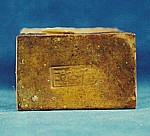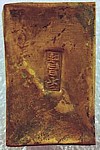|
|
Manufactures Marks Manufactures marks, they make life interesting to the historical archaeologist. Done is any language present around the world, the marks are a way to tell people what the product is, and just who made it. Most goods had labels of one form or another. However the manufactures mark was a way to go beyond the label and provide even more basic information right on the product itself. Glass bottles, such as the patent medicine bottle above have the manufactures' mark on them as part of the entire manufacturing process. When hot glass is blown into the mold and the bottle is made, the plates in the mold determine if this batch of bottles is going to be used to contain Dr. Lash's bitters6, or J.W. Hunnewell & Co's Universal cough remedy. It was not only a way to ensure your name was going to be seen by the consumer, but it also prevented easy recycling of the bottle for another product. Some of these markings can be traced and a date can be assigned to when the product was made. It may be possible to find advertisements that state how much the product sold for, and what the product was claimed to do. If place of manufacture is listed on the products then it is also possible to try and trace the trading patterns of the goods, and attempt to figure out how the product got from where it was made and into the site where it was found. The matchbox above is a good example of a traded good. The box itself lists the place of manufacture as being London. London at this time was a long ways away from Barkerville. The matches could not have come via plane, and train travel is just as unlikely. This particular box of matches likely had to come via steamer most the way from the companies' offices in London, a long trip simply to go out for a box of matches. The opium tins lids are another good example of manufacture's marks. These marks may give the brand name of the opium, where it was packaged, or it may be just an unrelated statement. If you hop over to the page on opium, you will see that the opium cans are covered in all sorts of Chinese script, the meaning or purpose of which may be varied. Giant catalogues from the early years of the big department stores may also offer a clue as to the manufacture, price and claims for an object. Many of these old catalogues also had illustrations of important or interesting objects. These can allow one to trace down the product and tell you exactly what the fragments of artifact once were. |




